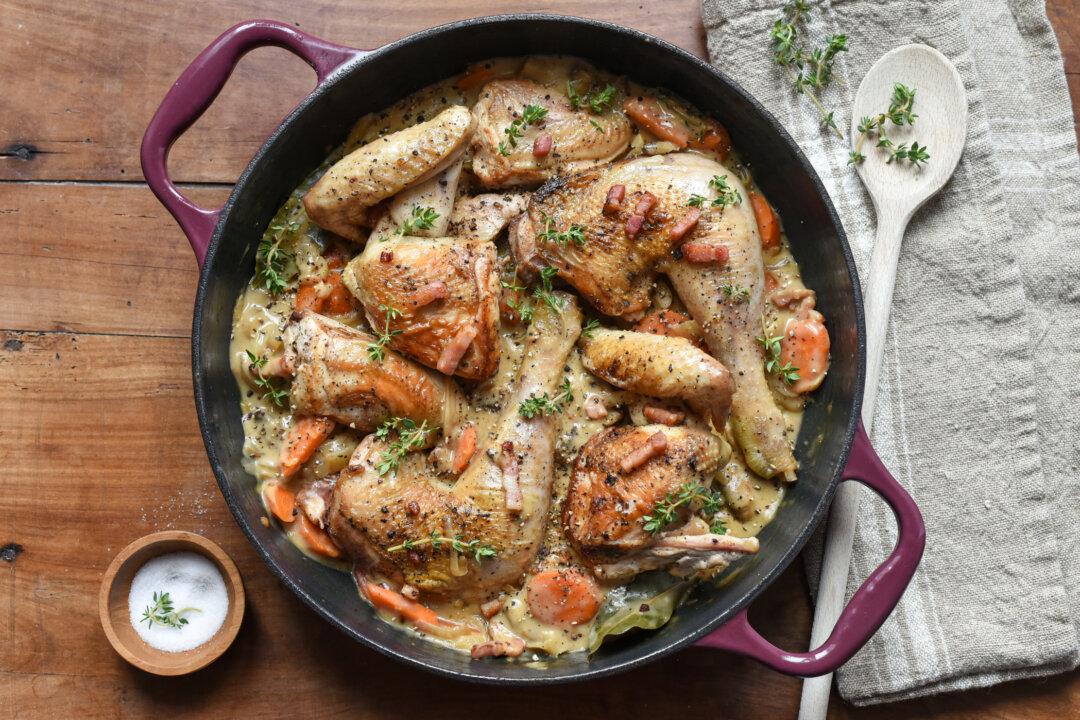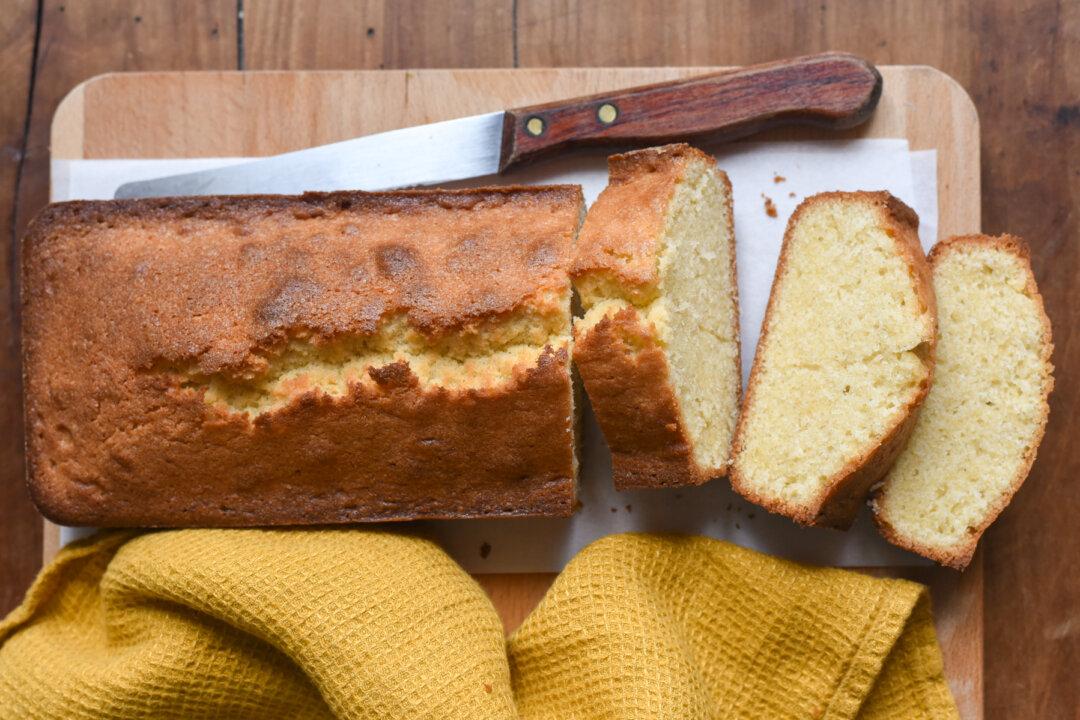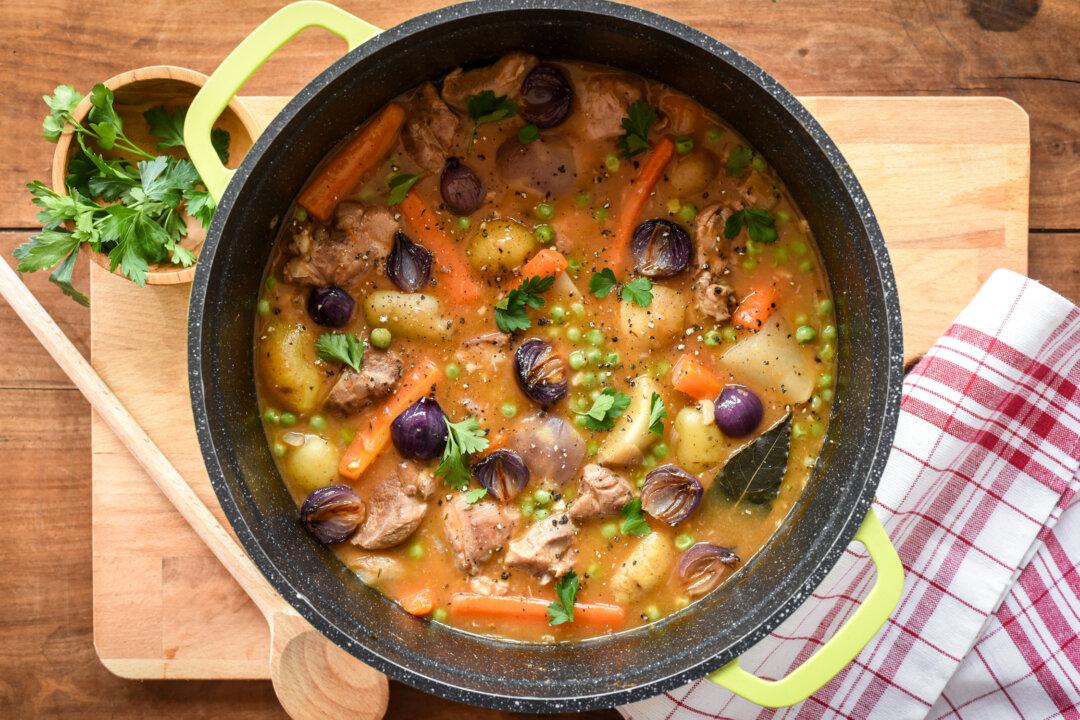You won’t find cinnamon, nutmeg, or any other typical fall baking spices in a classic French apple cake. Nor will you find any nuts, glaze, or extra crumble topping.
What you will find, though, are hefty chunks of apples, nestled in a tender, buttery, rum-infused cake, all finished with a crackly, sugary top. The apples shine beautifully.
This staple of French kitchens is the epitome of simple, cozy fall baking, and a timeless recipe that all home bakers should have in their repertoires.
What Makes It French?
Several regions of France have their own unique twists on apple cake, but this recipe is considered to be the most popular countrywide. Its popularity has reached outside French borders, too, thanks to various American chefs, such as Dorie Greenspan and David Lebovitz, sharing its recipe across the Atlantic.The fame of the classic French apple cake is in large part due to its delicate crumb, made with a generous amount of butter. In France, this is what we call a moelleux (literally meaning “soft” or “tender”) cake. In texture and taste, it is reminiscent of German versunkener apfelkuchen or Russian sharlotka, both made in similar ways, with a tender crumb and high apple-to-cake ratio.
But perhaps what really makes this cake distinct from its American counterpart is that it doesn’t call for those warm spices, often included in baked apple goods in North America. Instead, the French turn to booze: a healthy splash of dark rum complements the apples and infuses the cake with an incomparable flavor and fragrance. The rum is really the magic ingredient here.
Baking Tips for Success
Rum aside, this apple cake is a very simple, honest treat, made with basic ingredients that you likely already have on hand: flour, eggs, butter, sugar, and of course, crisp seasonal apples.This is an easy one-bowl recipe that any novice baker can make. With these tips and tricks, you will be set for guaranteed success.
Select the Right Apples
As with every apple recipe, this one begins with selecting a suitable apple variety. Choose baking apples that will hold their shape when baked—so they don’t turn into applesauce. Fuji, Honeycrisp, Mutsu, Jonagold, Pink Lady, Braeburn, and Granny Smith apples are all great choices here.This cake requires two large (or three small) apples. You can opt for just one variety or use a mix of them to create a contrast of tart, sweet, and mellow flavors. For instance, a Granny Smith (tart and crisp) paired with a Jonagold (sweeter, with honey notes) will create a beautiful contrast of flavors in every mouthful.
Make sure you cut the apples into uniform chunks so they disperse evenly throughout the batter, giving you a consistent texture after baking.

Peel, core, and cut the apples into uniform chunks. Audrey Le Goff
Ribbon the Sugar and the Eggs
The key to achieving a tender, airy cake crumb is to beat together the eggs and sugar until they reach the ribbon stage—perhaps the only crucial baking technique in this recipe.Ribboning is achieved by vigorously whisking the eggs and sugar together until the sugar crystals dissolve and the mixture becomes pale and thick. When you lift the whisk, the mixture should fall from the whisk in a smooth ribbon. You can whisk by hand, with an electric mixer, or in a stand mixer with the whisk attachment, but you’ll need to do so for a long period, at least 5 minutes. This step is essential to incorporate air into the batter and give you that desired texture after baking.

Whisk together the eggs and sugar until the mixture forms a ribbon. Audrey Le Goff
Use Great-Quality Rum
Since the unique taste of the classic French apple cake relies on a generous splash of rum, using a great-quality rum will make all the difference. Alternatively, a good-quality brandy, such as Cognac, or perhaps even better, Calvados (apple brandy from Normandy) would work great, too.Using rum is very highly recommended—it truly makes the flavor of the cake—but for a non-alcoholic version, you can substitute it with apple juice.

Fold the apple chunks into the batter. Audrey Le Goff
Trust the Ratio
When folding the apple chunks into the batter, you will probably think there isn’t enough batter to cover all the apples—but don’t fret, this is normal. Use a spatula to spread the thick, chunky batter into your prepared cake pan, making sure there are no air pockets. As it bakes, the batter will expand greatly and the ratio of cake to apple chunks will be just perfect.
Sprinkle the batter with a thin layer of sugar before baking. Audrey Le Goff
Don’t Skip the Finishing Touch
Right before baking, the cake is finished off with a thin layer of sugar, which will create its signature crunchy sugar top. About two tablespoons of sugar is enough to create the thin crust. This step cannot be skipped—imagine a crème brulée without its crackly burnt sugar top. Either recipe just wouldn’t be the same.
Bake until a knife inserted into the center of the cake comes out clean. Audrey Le Goff
Classic French Apple Cake
This cake is quite delicate in texture, so be gentle when removing it from the pan. A springform pan is preferred, although not mandatory.Enjoy the cake warm or cool, with a dollop of crème fraîche on top in true French fashion.
Makes one 8- or 9-inch cake
- 1/2 cup unsalted butter, plus more for greasing
- 2 large (or 3 small) baking apples (such as Fuji, Honeycrisp, Mutsu, Jonagold, Pink Lady, Braeburn, or Granny Smith)
- 1 cup all-purpose flour
- 1 teaspoon baking powder
- 1/4 teaspoon salt
- 2 large eggs
- 3/4 cup sugar, plus 2 tablespoons for sprinkling
- 1 teaspoon vanilla extract
- 3 tablespoons dark rum (or Cognac, Calvados, or apple juice)
Melt the butter in a small saucepan and set aside to cool.
Peel and core the apples, then dice them into 1/2-inch chunks.
In a small bowl, whisk together the all-purpose flour, baking powder, and salt.
In a large bowl, vigorously beat the eggs and sugar together until the mixture turns pale and thick, and falls from the whisk in a smooth ribbon. It should take at least 5 minutes. Whisk in the dark rum and vanilla extract.
Whisk in half of the flour mixture and gently stir. Add in half of the melted butter and gently stir. Stir in the remaining flour mixture, then the rest of the butter.
Fold in the apples until they are evenly coated with the batter. (It will look like there is too much apple and not enough batter, but this is normal.)
Scrape the batter into the prepared cake pan, making sure there are no air pockets, and smooth the top a little bit with a spatula. Sprinkle 2 tablespoons of sugar evenly over the top of the batter.
Bake the cake for 45 minutes, or until a knife inserted into the center comes out clean. Let the cake cool for 15 minutes, then carefully remove it from the pan.
Enjoy warm or cool, served with crème fraîche.
Audrey Le Goff is a French food writer, photographer, and creator of the food blog, “Pardon Your French,” where she shares recipes and stories from her beloved home country, France. She is the author of the cookbook “Rustic French Cooking Made Easy” (2019). She currently lives in Niagara, Canada. Follow her on Instagram @pardonyourfrench





